1909 VDB Penny Coin Value: How Much Is It Worth?
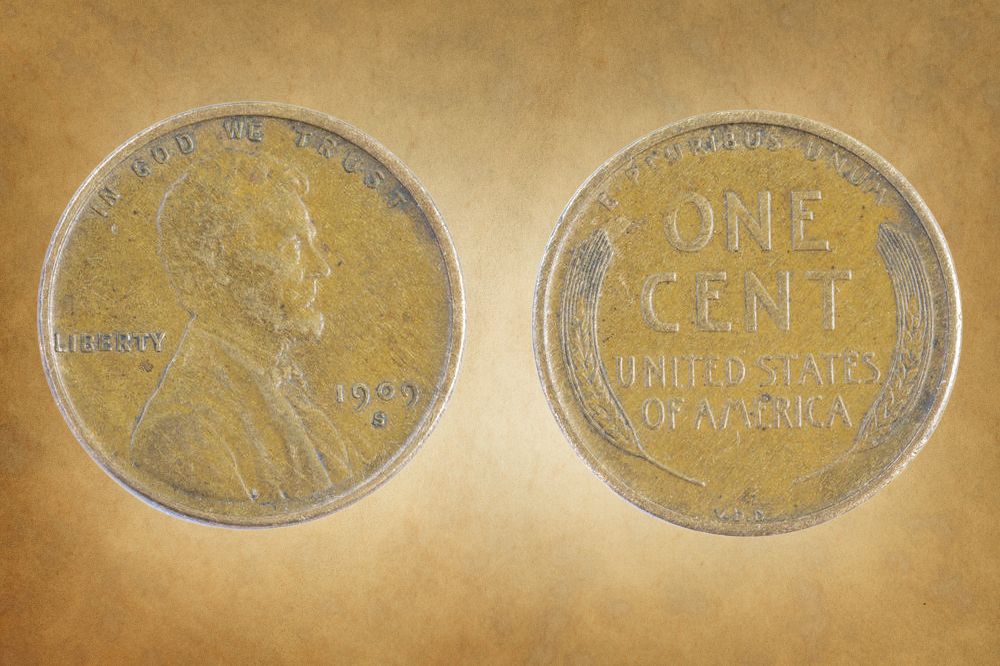
A penny is a 1-cent coin, both in America and in the UK. And US pennies are typically known as Lincoln Cents, though they’re further sub-categorized by their reverse design (that’s the tails side of the coin). VDB is Victor David Brenner, the penny’s original designer. So let’s look through some crucial factoids and discover the most accurate 1909 VDB Penny Value.
1909 VDB Penny Value Chart |
||||
| Mint Mark | Good (G 4) | Extremely Fine
(EF 40) |
Mint State
(MS 63) |
Proof
(PR 63) |
| 1909 (P) VDB No Mint Mark Penny Value (Philadelphia) | $13 | $20 | $34 | $3,126 |
| 1909-S VDB Penny Value (San Francisco) | $847 | $1,458 | $2,277 | No S Proofs |
1909 VDB Penny Value Guide
The VDB Penny was only even coined at the Philadelphia and San Francisco mints because Denver didn’t start minting pennies until 1911. These were all Wheat Pennies or Wheat Cents since the coin had two ears of durum wheat on the back. Let’s look at the coins individually.
1909 VDB No Mint Mark Penny Value
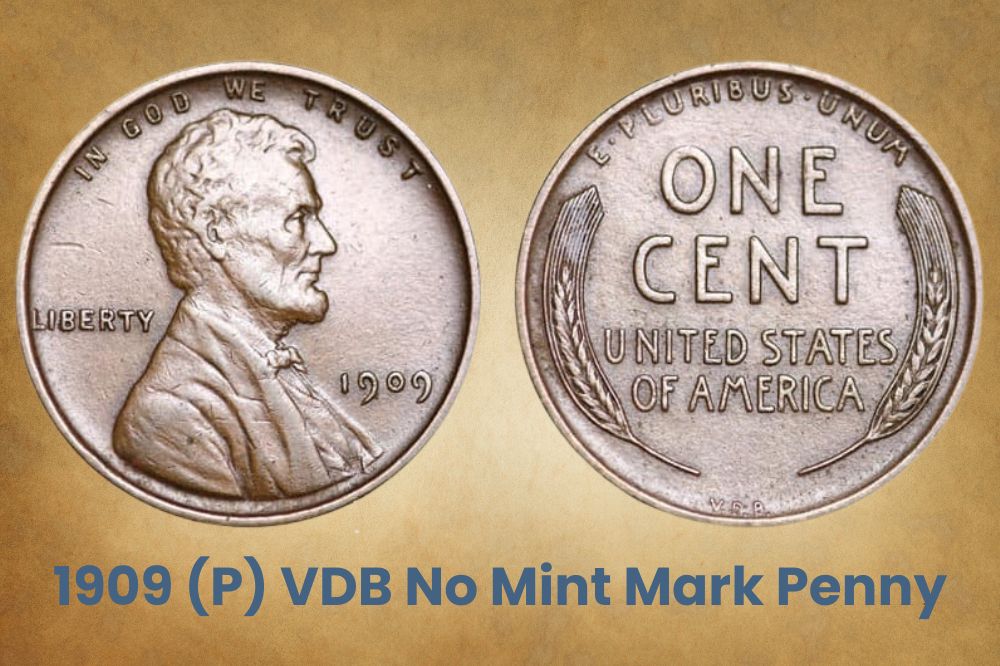
In 1909, the Philadelphia Mint produced 27,995,000 VDB pennies and 72,702,618 no-VDB pennies. The coin isn’t especially rare, and you’ll only get about $30 in mint state. In 2017, a 1909 VDB Penny in MS67+ RD was sold for $8,225. And in 2021, a 1909 VDB MS 68 RD sold for $54,600. Because high grades are so rare, that half-step difference is worth $50K!
1909-S VDB Penny Value
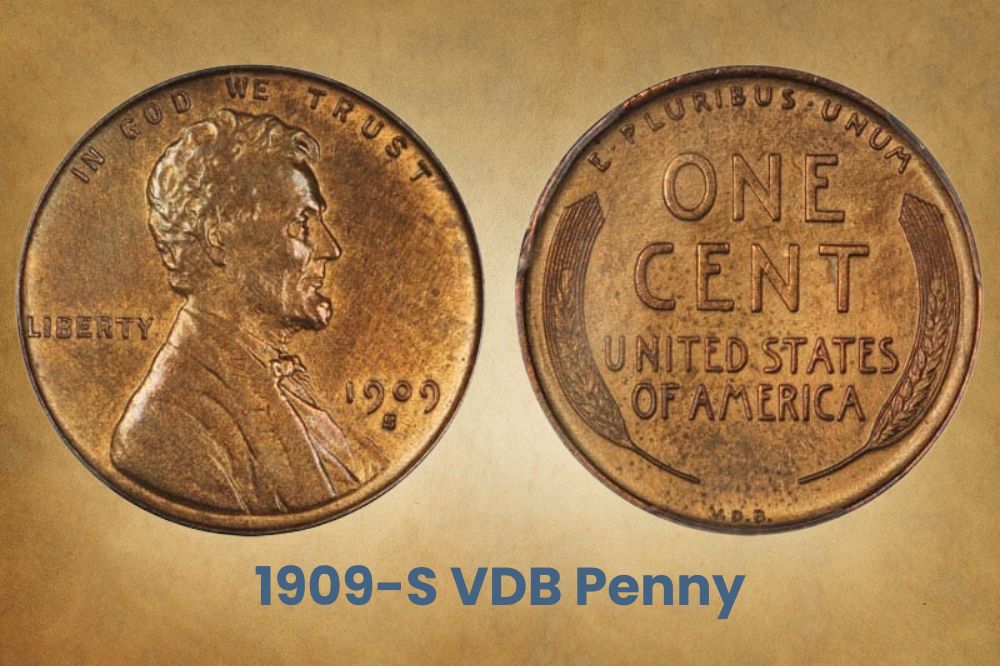
The San Francisco Mint was fairly busy in 1909. It produced 484,000 VDB pennies and 1,825,000 no-VDB pennies. These coins all bore the S Mint Mark. In G4, the coin is about $800. In MS 63, it’s over $2,000. In 2014, this coin set a record when a 1909-S VDB in MS 67 RD sold for $117,500. Then in 2022, a 1909-S VDB in MS 67 RD was sold for $168,000.
1909 VDB Proof Penny Value
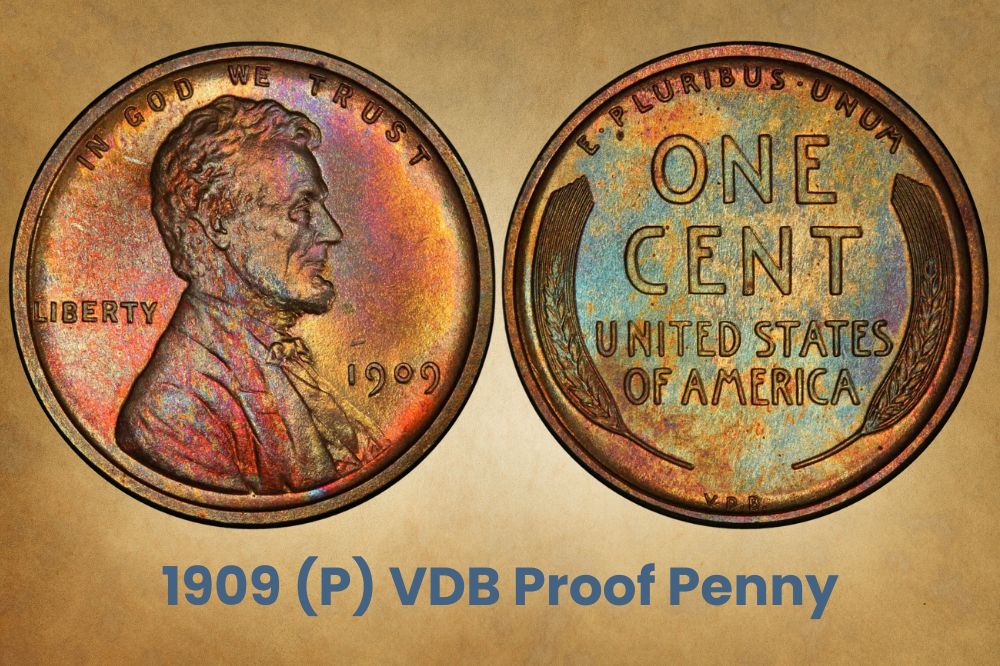
The Philadelphia Mint produced 1,194 proof pennies with VDB and 2,352 proof pennies without VDB. All these coins were matte proofs, meaning they didn’t have the mirror polish that today’s proof coins typically have. In 2014, a 1909 VDB 1c PR 67+RB sold for $258,500.
Related Posts: 16 Most Valuable Wheat Penny Errors
1909 VDB Penny Errors
Coin errors can be worth a lot of money, but it helps if you know what specific flaws to look out for. This can be especially important because Lincoln Pennies are counted among the most counterfeited coins in the world. Be extra careful not to end up with a fake Wheat Cent!
1909 VDB Penny DDO Error
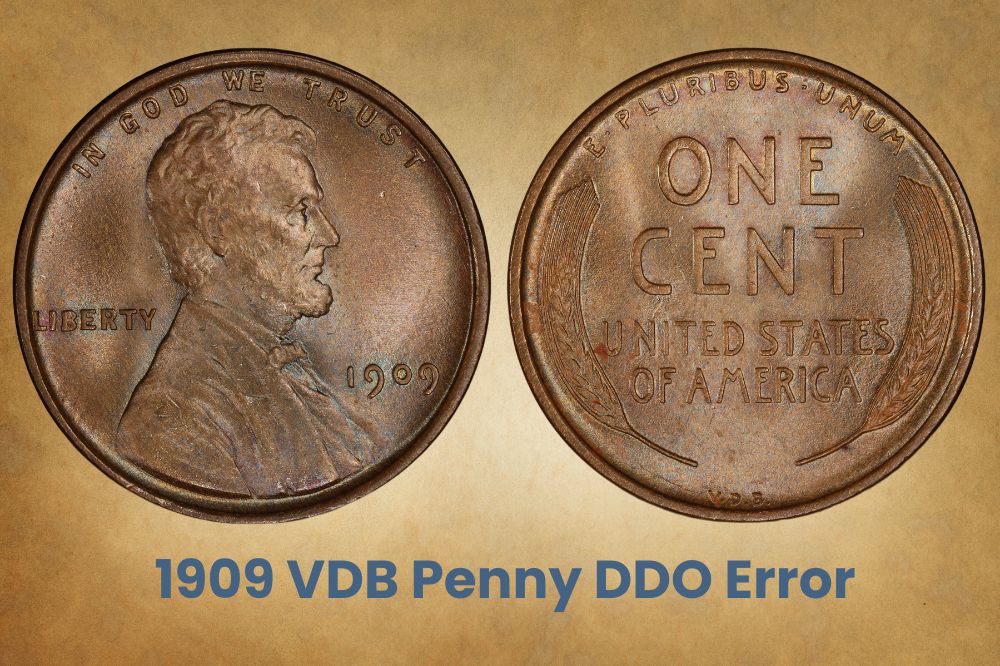
A DDO is a double-die obverse error. That means the obverse die that’s used to make the front of the coin was flawed. The die moved between strikes, creating a doubling effect and all coins minted with that die have the same error. This is called a variety. The DDO is clearest on 1909 and Liberty. The coin is worth $70 in VF 20 and $1,000 in MS 65 RD.
1909 VDB Penny Die Chip DDO Error
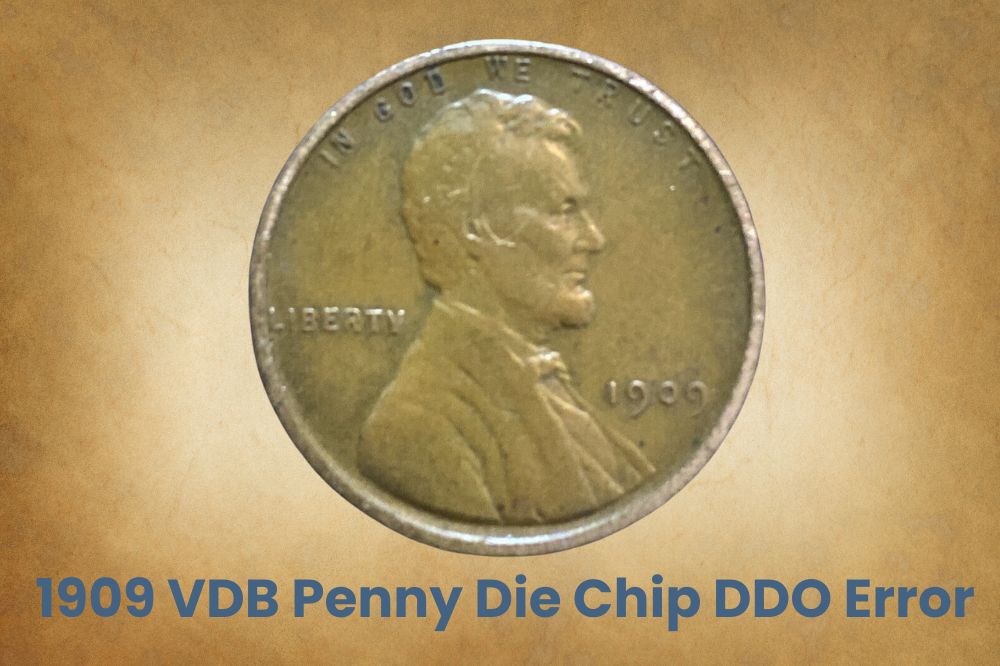
Ordinarily, you can catch doubling on letters and numbers because that’s where the errors are most distinct. But there’s a specific variety of 1909 VDB pennies where the B and R in Liberty have die chips inside the round parts of their lettering. This can be a valuable coin flaw. A 1909 VDB Penny with DDO plus a die-chip B and R can sell for $9,600 in MS 67.
1909 VDB Penny Off-Set Doubling Error
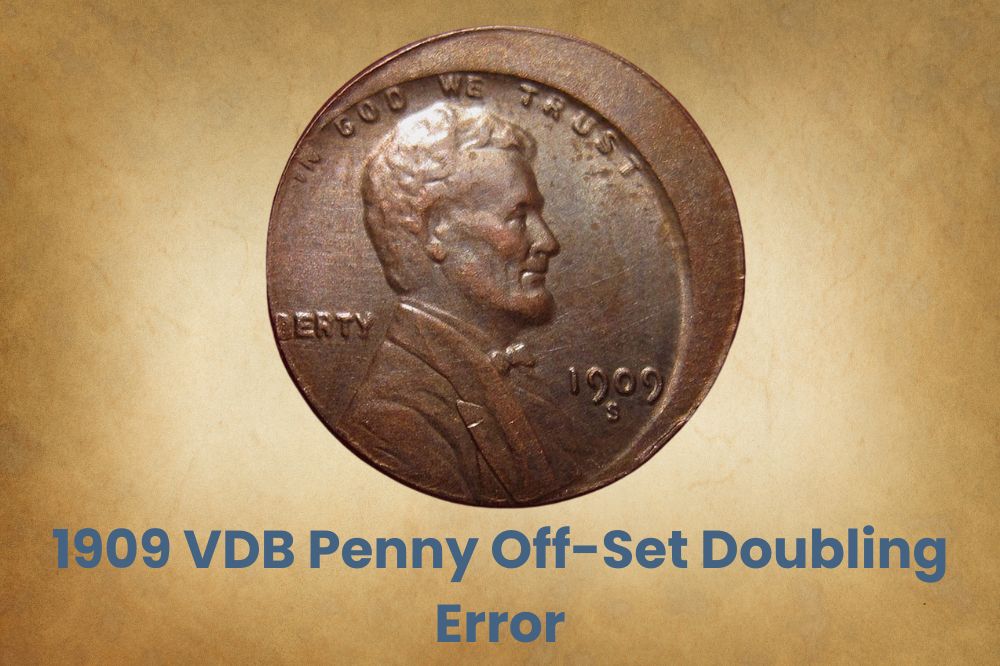
Because DDOs and DDRs are such common errors, some are sub-classified by their unique features. Take the FS 1101 designated as Class IV Hub Error. It indicates off-set hub doubling on the hub itself rather than the die, and it causes doubling on Lincoln’s lips in addition to the mint date and the Liberty legend. In MS 67 RD, this error sold for $12,000 back in 2018.
1909 VDB Penny DDO FS 1102 Error
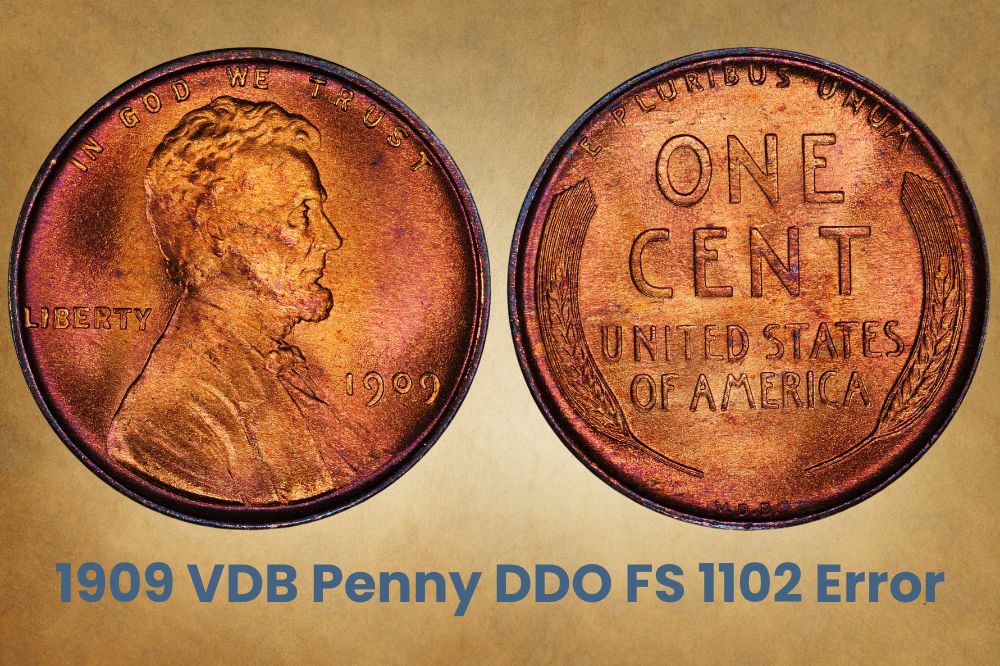
Yet another version of the double die obverse is listed as FS-1102. On this coin, you can see a small slash on Lincoln’s neck, in front of his Adam’s apple. It’s defined as a vertical die clash, and it’s a tricky error to spot so you may need a loupe, or maybe get it graded to be sure you have the right flaw. In MS 67 RD, this 1909 VDB penny was auctioned for $24,150 in 2012.
Related Posts: 19 Most Valuable Lincoln Memorial Penny Worth Money
History of the 1909 VDB Penny
The first American penny was minted in 1793 and it was pure copper. But copper is soft, so a 5% mix of tin and zinc was added to harden the coin and extend its circulating life. This first penny had a woman representing the Goddess of Liberty and was a tribute to that iconic statue in Manhattan. From 1793 to 1908, all pennies featured some version of Lady Liberty.
Before that, American coins had British monarchs on them, because the US was initially a colony. After the Revolutionary War, George Washington – the first US President – insisted many of these colonial practices should stop, including placing leaders on currency. So until the 1900s, US coins featured symbolic portraits that expressed peace, liberty, and freedom.
Then in 1905, Theodore Roosevelt – the 26th US President – asked the mint to hire artists to redesign American coins and make them pretty. Augustus Saint-Gaudens worked on the gold coins, and when he died of cancer in 1907, some of his assistants continued the project. They included Victor David Brenner, who redesigned the penny. His design was adopted in 1909.
Generally speaking, coin designers are allowed to place their initials on the coin. But Brenner wrote his full surname on the front of the coin. Frank Leach (the Mint Director) objected so Brenner placed VDB on the back instead. The coins were released to the public on August 2nd, 1909. But the public was still unhappy, saying the initials were too big and advertorial.
The VDB Controversy
Initially, the Mint wanted to replace the VDB with a smaller B, but earlier coins designed by Charles Barber already had B for Barber, and the change would take 14 days, so that wouldn’t fly. A much quicker option was to remove the signature altogether, which would only take 3 days. So the Mint took out the VDB initials, although Brenner was quite miffed about it all.
By this time, almost 28.5B pennies had been coined with VDB on the reverse. This initial batch still draws a lot of interest from numismatists and resellers. After the furor, roughly 78.5B more were made without the VDB. And the controversial VDB wouldn’t reappear on Lincoln Cents until 1918 when a much smaller VDB slipped onto Lincoln’s shoulder cut-off.
Whenever we talk about Lincoln Cents, we start the count in 1909. But before this, the US had two other small cents that were 19.05mm in diameter, plus a whole series of large cents, some as big as 29mm. Also, certain cents may have the same style or error if they were made using the same die. These identical batches are sometimes called varieties. Let’s review a few.
The reason we switched to Lincoln Cents in 1909 was to celebrate 100 years since his birth. And because he’s such a landmark president, the coin was redesigned to mark key dates such as his sesquicentennial in 1959 (that’s 150 years after his birth) and his bicentennial in 2009 (200 years since he was born). The switch was aesthetic too – Roosevelt wanted artsy coins.
In 1909, the Lincoln Cents were introduced, but some of the earlier Indian Head Cents were minted as well. They featured a depiction of Lady Liberty (posed by Sarah Longacre) wearing a Native American headdress. Notably, the style of feathers depicted on the coin was usually worn by men. As for the Lincoln Cents, you can find them in both VDB and no-VDB varieties.
Comparing 1909 Penny Varieties
Some of the other 1909 Penny varieties are harder to spot without a jeweler’s loupe or a coin microscope. Focus on the letters in the legends, and the numbers in the date. Specifically, look at the words United and America. On pennies from the 1980s and 1990s, you might spot Wide AM or Close AM cents. This describes the spacing between the A and M in America.
And on 1-cent coins from 1982, you’re thinking about the date size as well as the metal mix. Starting this year, the coin’s composition changed to 97.5% zinc with a 2.5% copper coat, and some coins were minted with large minting dates while others had smaller dates. This led to Big Date and Small Date pennies. But back to 1909, check the letter N in the word United.
This is sometimes deep (Deep N) and sometimes shallow (Shallow N). These changes will not affect pricing, but some numismatists want every variety. So if you have one they don’t own yet, you can make a good profit at auctions if you keep all your coin varieties carefully cataloged. Incidentally, 1909 was the first year when In God We Trust appeared on pennies.
The motto was introduced on the 1864 two-cent coin before it popped onto the penny. This might be because the obverse had too much space at the upper collar, so the mint added In God We Trust for better balance. It’s the only circulating coin with this legend at the top. Usually, Liberty runs along the top while In God We Trust is closer to the middle of the coin.
Related Posts: 19 Most Valuable Wheat Penny Worth Money
How to identify 1909 VDB Penny?
Lincoln Cents were first minted in 1909 and are still coined today. And while no coins had VDB between 1911 and 1917, those earliest batches did have their fussy designer’s initials. That said, 1909 saw eight varieties of 1-cent coins. They included two Indian-Head cents, three VDB cents, and three no-VDB cents. Of these varieties, two are Lincoln proof pennies.
The Obverse of the 1909 VDB Penny
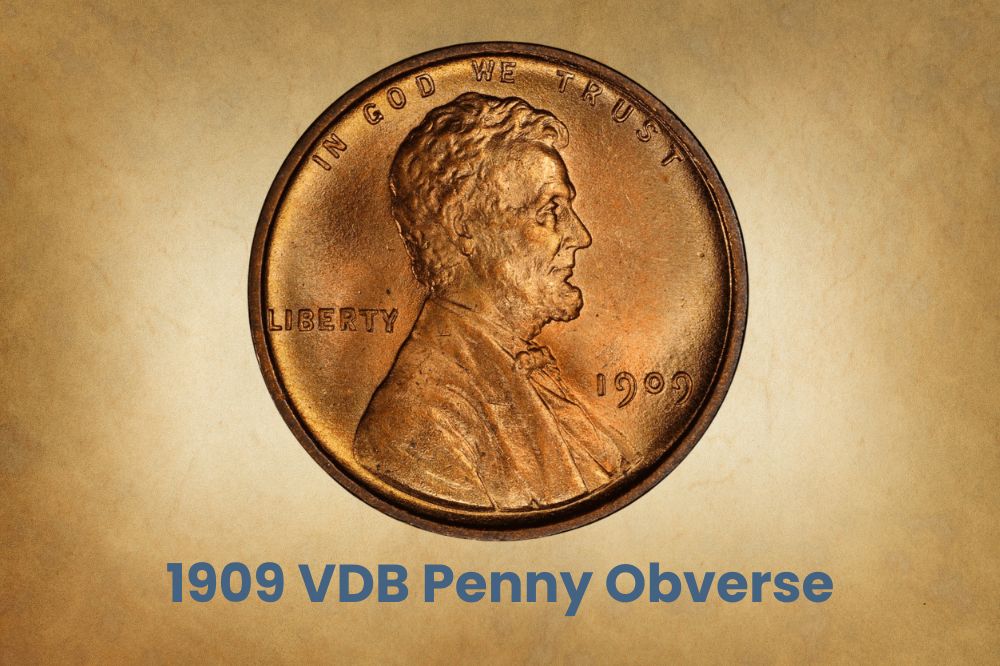
The obverse (heads side) of the 1909 VDB Penny has a portrait of Abraham Lincoln. Brenner based it on an earlier image he had used for a desk plaque. The plaque was commissioned in 1907 for Gorham Manufacturing. In the portrait, Lincoln faces right, with the mintage date.
The mint mark – where applicable – is in front of his chest, below the date. Behind him is the legend Liberty, and above his head is that heavenly motto, In God We Trust. 1909 Pennies are copper coins so their color is graded as RD (red), BN (brown), or RB (reddish-brown).
The Reverse of the 1909 VDB Penny
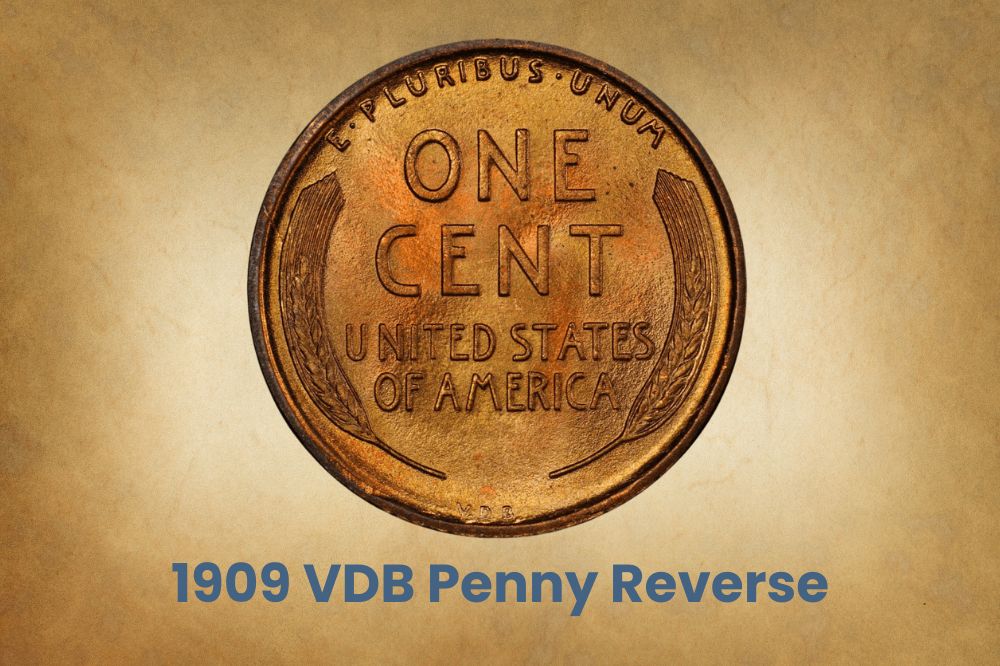
The reverse (tails side) of the 1909 VDB Penny features two stalks of durum wheat. Brenner borrowed this design from a French coin, though the French version had tree branches instead of wheat sheaves. The ears of wheat are arranged along the side rims of the coin.
Between them is the denomination – One Cent – followed by United States of America. E Pluribus Unum runs along the upper collar of the coin, with dots between the words. At the base of the reverse are his initials, VDB. These initials also have dots after each letter, V.D.B.
Other Features of the 1909 VDB Penny
The 1909 VDB Penny is 19.09mm in diameter (0.75”) and weighs 3.11g. It was minted using 95% copper plus a 5% mixture of tin and zinc. The edges of the coin are smooth or plain and have no reeds. The original obverse is still in use, but the reverse has changed several times.
How Many 1909-S VDB Pennies Are Left?
About half a million 1909-S VDB pennies were coined and by 2020, PCGS (Professional Coin Grading Service) believed about 50,000 still exist. At the time of writing (November 2022), USA Coin Book has 4 listed for sale, with their stated value ranging from $800 to $3,000.
What is the Most Valuable 1909 VDB Penny?
To date, the most valuable VDB Penny is a 1909 (P) VDB Proof Penny graded PR 67+ RB. In August 2014, it sold at Heritage Auctions for $258,500. But 1909-S VDB cents can be quite valuable as well. In 2022, one 1909-S VDB Penny in MS 67 RD was auctioned for $168,000.
